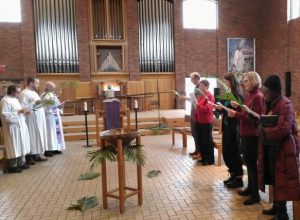This week, we would like to share a blog post written by Cassie Dong, our Communication Coordinator. Cassie was inspired to write this after participating in the “Palm Friday” chapel at Augsburg University last Friday. This blog post illustrates the Interpretative work our faith communities are working on.
If you are looking for a straight answer, stop here; there is none. If you would be willing to dwell into your neighbors’ story, your story, and God’s story, then keep reading. It will be long, but it will all make sense at the end. After all, only when you weave these very different stories together can you find how God is calling us to show up in our community. Be patient for this work is slow and challenging.
Our Story: Are we feeling guilty with “being Christian”?
As a young leader, I am used to being vocal about my beliefs. I speak up for people who have been marginalized and have no voice. Yet, one of the most difficult things for me is to learn how to publicly proclaim the good news of Jesus Christ in a way that speaks true to the communities that I serve. It is challenging to find the right balance between living out my faith in the public square and to be compassionate toward people who have experienced trauma and pain at the hand of the church. I am disheartened to see faith communities resistant to use “God’s language.” Many faith communities come forward to acknowledge mistakes the church has committed in its long history. However, instead of closely looking at and changing policies, systems, processes, and cultural norms of white supremacy, colonization, and toxic masculinity, many people respond by no longer talking about their Christian faith in public. Are there ways for us, as Christians, to declare that Christianity is a religion of love? Can we live out our faith and allow God’s stories and our stories to guide us in accompanying our neighbors?
God’s Story: Palm Sunday
To answer those questions above, let me first share with you one of God’s stories. I would make an assumption that many of us have read or heard of the story in Mark 11:1–11 in which people “spread branches they had cut in the fields.” They carried these palms as they followed Jesus entering Jerusalem while shouting praises to God. From this Biblical narrative, we have Palm Sunday—the Sunday before Easter when many churches celebrate the triumphal entry of Jesus into Jerusalem by carrying palm fronds.
Let’s stop here for a moment and ask a few questions. During church service on Palm Sunday, when being given those palm branches, what do you do with them? Do you wave them while entering the chapel? Do you hold on to them throughout the entire service? Bring them home when the service is done? Do you know what exactly do these palm branches represent?
Our neighbor’s Story: The March for Our Lives
I would need to tell you about my neighbor’s story in order to answer those questions above. In support of stronger gun violence prevention measures, on Saturday, March 24, 2018, the March for Our Lives took place in Washington D.C. where between 200,000 to 800,000 people participated. In other places in the country, thousands of people—many were high school students and young adults—marched onto the street with protest signs sending strong messages against gun violence and demanding for change. Among those protest signs, there were some palm branches: some were held high above the head; others were tied to protest signs. Yes, Saturday, March 24, 2018 was the day before Palm Sunday.

Weaving together our neighbors’ story, our story, and God’s Story
On April 12, during the “Palm Friday” chapel, Augsburg University’s associate pastor Justin Lind-Ayres told us about his experience participating in the 2018 March for Our Lives. He compared those palm branches with protest signs we have today. He shared, when people held onto the branches and followed Jesus into Jerusalem, they were marching with Jesus to demand for a change and to celebrate the good news of Jesus Christ. Similarly, people who were marching with palm branches at the March for Our Lives were also advocating for social justice while celebrating the incredible leadership of young people who organized and led this national demonstration. Moreover, these people were explicit about their identity. They sent out an important message: the Christian community is standing with the victims of the Parkland shooting and those young leaders who fight against gun violence.
I shared with you about our concerns as Christians, Mark 11:1–11, the sermon about Palm Sunday, and the presence of palm branches during the March for Our Lives because these stories teach us how to live out our faith. No, it is not enough to just listen to our neighbors, or to only understand our identity, or to only know God’s story. Faith communities must be able to weave together these three stories to discover: Who is God calling us to be? What is God calling us to do? How is God calling us to show up in this community? Instead of ambiguously saying “we are not that kind of church” or “we are not that kind of Christian,” we must be explicit about our identity and our values—with words and actions. How can we fix our mistakes and/or remove misunderstandings and assumptions that people may have about the church and our faith without actually showing up in the community and being clear about our true Christian values? I strongly believe, as faith communities, we are called to proclaim the good news of Jesus Christ to challenge the particular bad news in our neighborhood. Only when we show up in the neighborhood—with humility and compassion—can we understand the bad news and truly discern the good news in our specific context. This is how we live out our faith.
